Wireworms
Family Elateridae (several species)
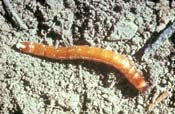
Figure 1. Wireworm Larva
Description
Several species of wireworms, all quite similar in appearance, attack the roots of many crops. The name wireworm aptly describes these insects (Fig. 1). When young they are cream colored, about 1/4 inch long, and less than 1/16 inch in diameter; when mature they are 1 1/4 to 1 1/2 inches long and about 1/8 inch in diameter. The pupal stage is free, the entire structure of the adult's body being apparent. The adult is a click beetle (Figs. 2,3). When placed on its back, it flips into the air with an audible snap and lands on its feet. The eggs are tiny, white globules found in the soil.
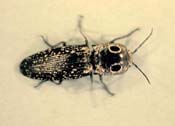
Figure 2. Wireworm Adult
Life History
The winter is spent as a larva or beetle in the soil. In the spring the adults become active, fly about, feed, and lay their eggs. Adults may live for as long as 12 months. The larva may live for two to six years in the soil, feeding on roots of weeds, grasses, and other crops. The pupal stage is short, perhaps two weeks, and is spent in a cell in the soil. With this long a life cycle, one generation may require six or seven years for completion.The winter is spent as a larva or beetle in the soil. In the spring the adults become active, fly about, feed, and lay their eggs. Adults may live for as long as 12 months. The larva may live for two to six years in the soil, feeding on roots of weeds, grasses, and other crops. The pupal stage is short, perhaps two weeks, and is spent in a cell in the soil. With this long a life cycle, one generation may require six or seven years for completion.
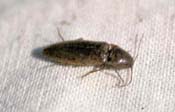
Figure 3. Wireworm Adult
Damage
In root crops, like potatoes, wireworms drill into the actual tubers. In other crops, they drill holes in the underground portion of the stalk and may even destroy the seeds before germination. In corn specifically, the worms hollow out the seed, preventing germination. If they do not attack the seed, they drill a hole in the stalk and sometimes all the way through it (Fig. 4). The stalks of small seedlings may be hollowed out up to and even above the soil surface.
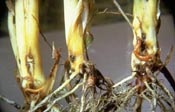
Figure 4. Wireworm Damage
to Corn
First evidence of wireworm damage to corn stands is lack of germination. The wireworm eats out the seed germ, and only a few plants will appear in a large area. If the seeds do germinate, the worm attacks the small seedlings, which usually wilt and die, adding to the spotted appearance of the stand. They then attack the plants that escape, causing the center leaves of these larger plants to wilt. If the larger plants do not die, they are severely stunted or grow in a distorted fashion. A new shoot will emerge from the hole in the plant below the soil surface. These distorted plants may live but will not produce an ear.
Damage may continue for some time, and plants will still be wilting when they are more than knee-high. Damage occurs primarily in the spring during cool, moist weather. As soil temperatures rise and soil moisture decreases,the wireworms migrate deeper into the soil to find cooler temperatures and moisture. Thus, little damage occurs after June. However, one exception is peat soil, in which wireworms may be a serious problem all season long.
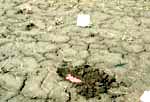
Figure 5. Wireworm Bait
Station
Wireworms are usually most damaging in bottom lands or poorly drained areas on upland soils. Water spots in the field often have the heaviest populations. In some years of general wireworm damage, there seems to be a relationship between crops that were in the field two years before corn is damaged. Small grains, especially wheat, are the most suspected crop.
Wireworm infestations are generally related to crops or weeds that grew in the damaged field 2 to 4 years before. Cornfields planted after small grains (including corn planted after double-cropped soybeans) and grass pastures or grass hay often exhibit the greatest potential for wireworm problems. Wireworms may also be concentrated in low, poorly drained areas of fields or high, drier areas of the field, depending on the species.
Using Solar Bait Stations to Monitor for Wireworms
Postemergence insecticides or "rescue treatments" are not effective for wireworm control.
Ultimately, the only way to know for certain whether wireworms pose a threat is to look for them before planting corn. Efforts to aid the search for wireworms led entomologists at the University of Missouri to develop the idea of solar bait stations (Fig. 5). These bait stations are simple to create, and the results are easy to interpret. Although several studies over the years have focused on finding a better way to detect wireworms, solar bait stations have continued to win out.
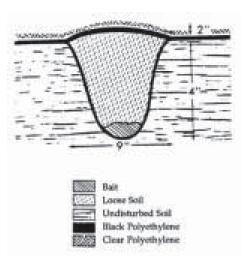
Figure 6. Cross-section of a solar bait
station for sampling for wireworms.
- Dig a hole about 3 to 4 inches deep and 9 to 10 inches wide at the soil surface.
- Bury 1/2 cup of a mixture of equal parts untreated corn and wheat at the bottom of the hole. The germinating seeds attract wireworms.
- Fill the hole and mound a "soil dome" over the covered bait to serve as a solar collector and to prevent standing water.
- Cover each mound with an 18-inch-square sheet of black plastic, topped with a 1-yard-square sheet of clear plastic, and cover the edges with soil to hold the plastic sheets down. The plastic collects solar radiation and speeds germination of the corn and wheat. A cross-section of a wireworm bait station is illustrated in Figure 5.
- A few days before planting, remove the plastic and soil covering the bait and count the number of wireworm larvae found at each station. Wireworm larvae are 1/2 to 1-1/2 inches long and usually are hard, smooth, dark reddish brown, and wirelike. However, some species are soft-bodied and are white or yellowish.
- Place about a dozen bait stations per 40 acres. Your placement of the bait stations should represent different areas of a field.
If you find an average of one or more wireworms per bait station, consider the use of a registered seed treatment or soil insecticide (see Table 2 in the 2004 Illinois Agricultural Pest Management Handbook). A hopper-box seed treatment (e.g., Agrox Premiere, Kernel Guard) will protect the seeds but will not prevent wireworms from attacking the stem beneath the soil sur-face. If your baiting procedure pin-points wireworms in a specific area of the field, consider treating only the infested area rather than the entire field. You'll save money by reducing the amount of insecticide applied in the field.